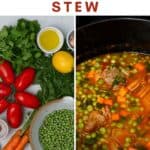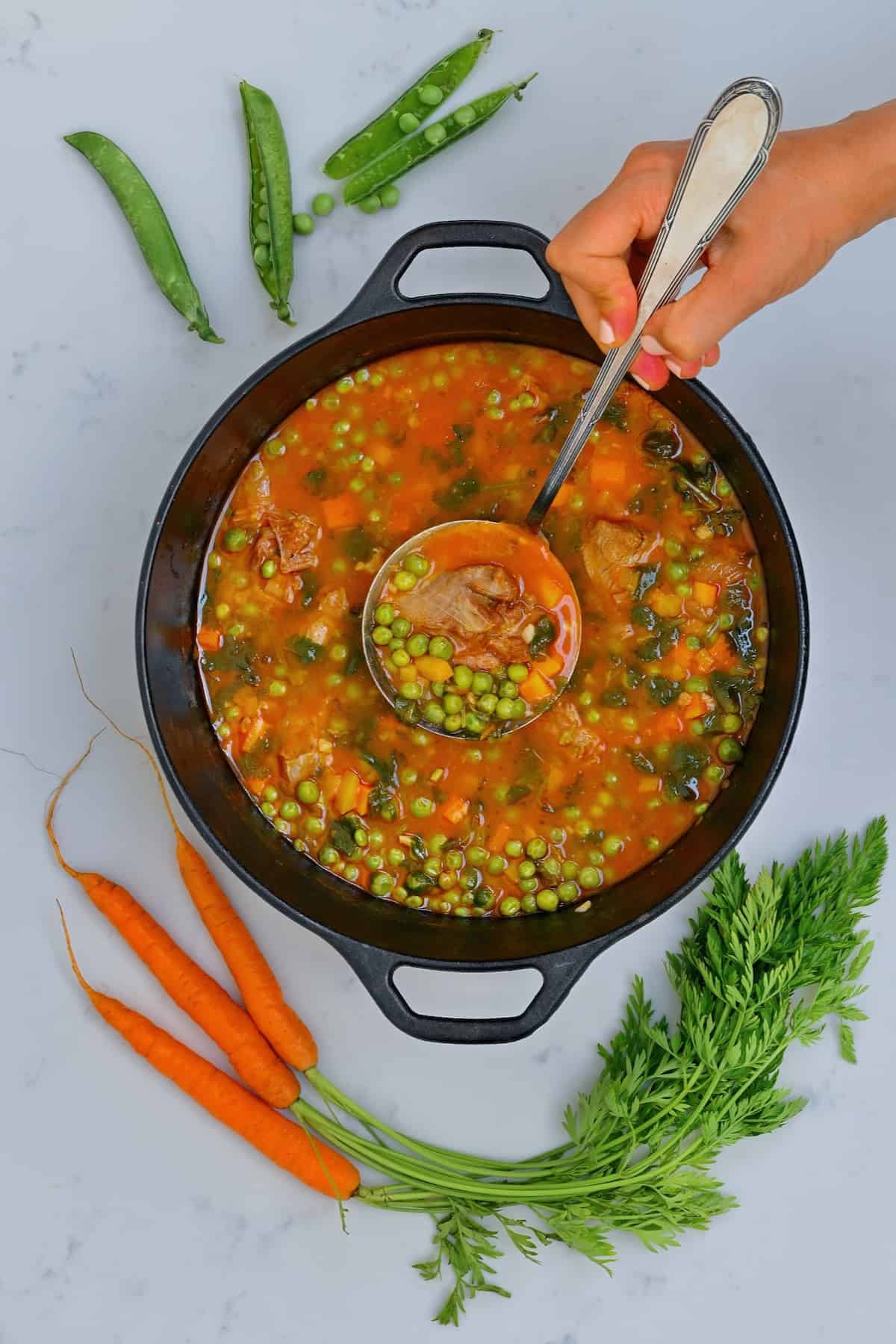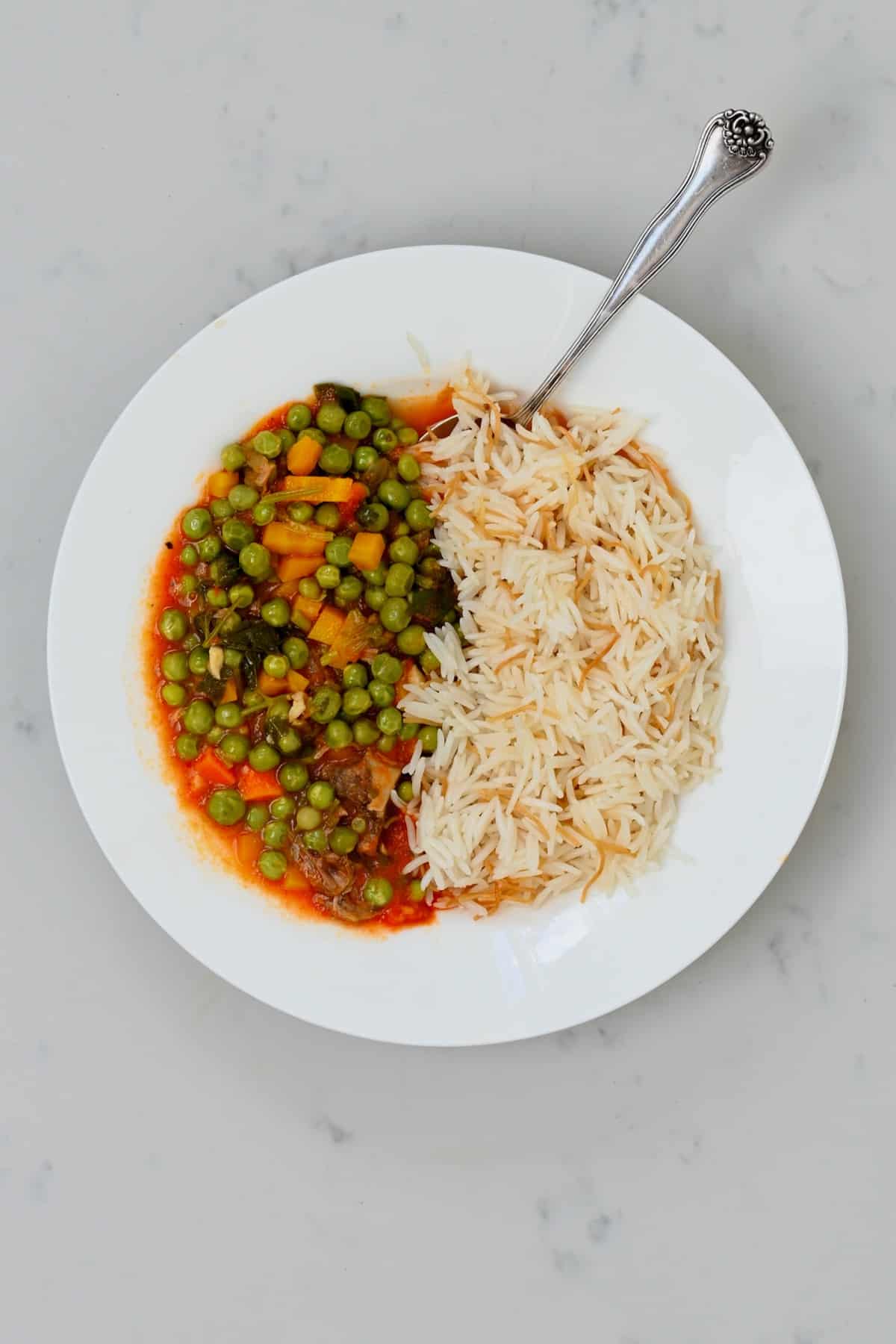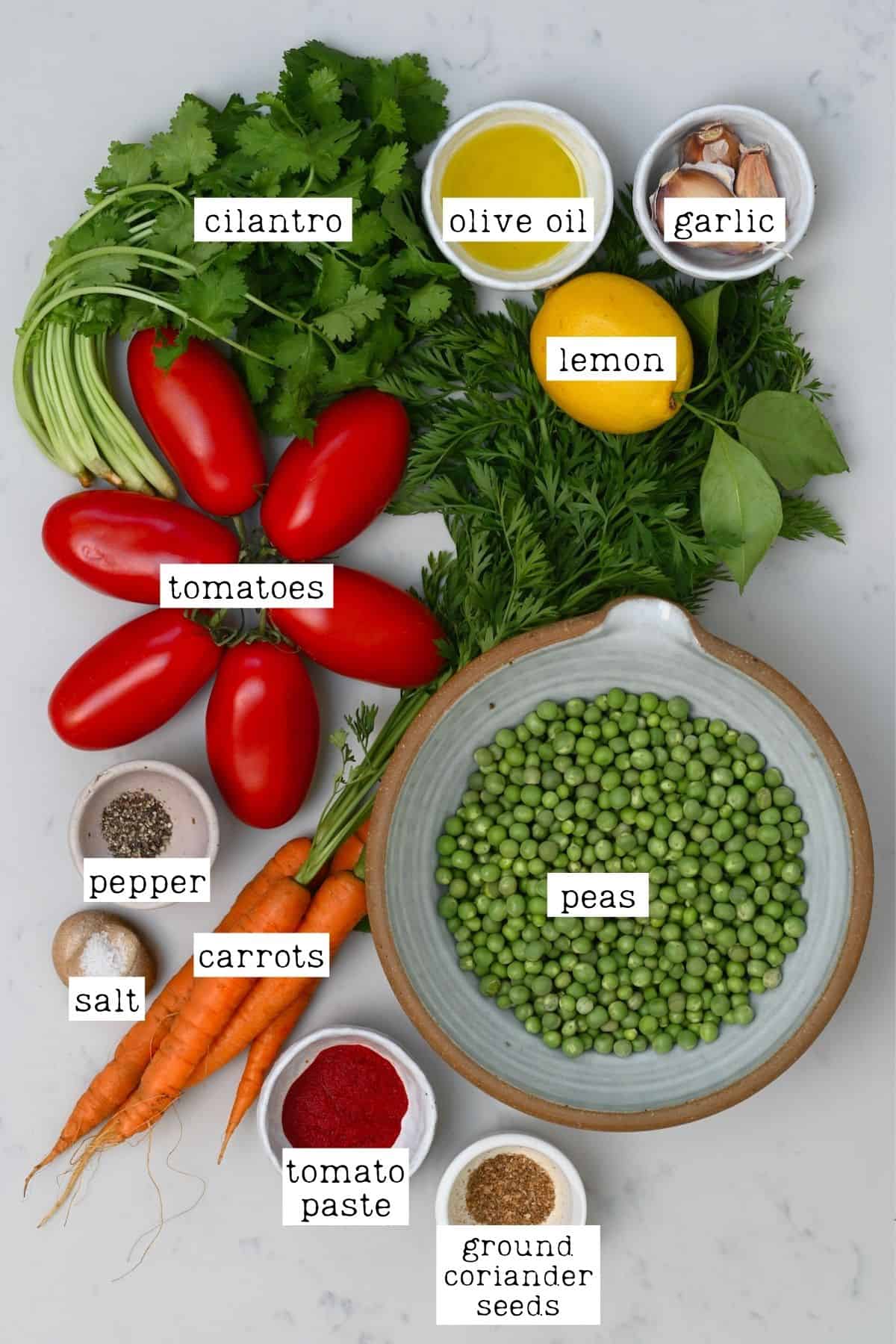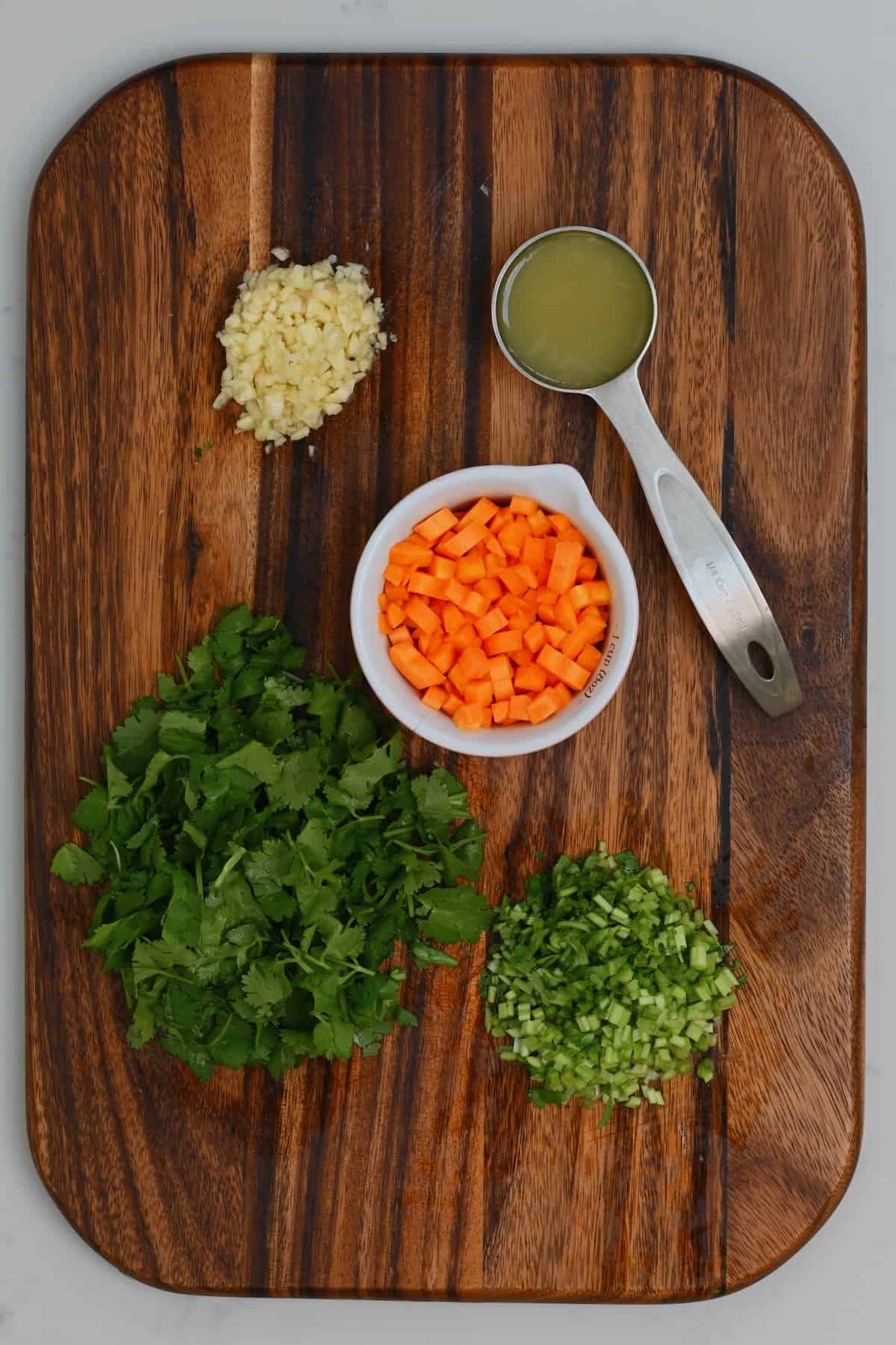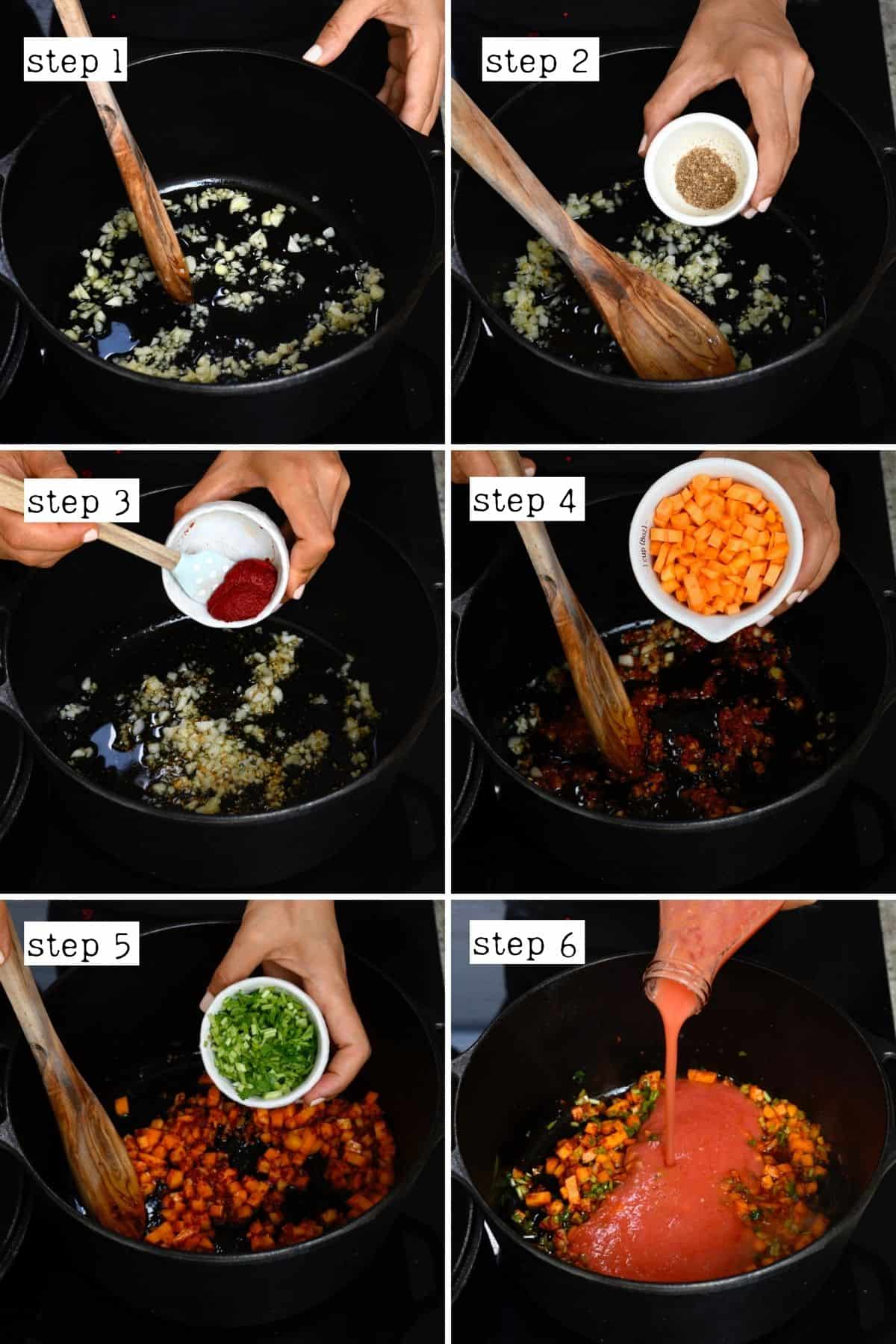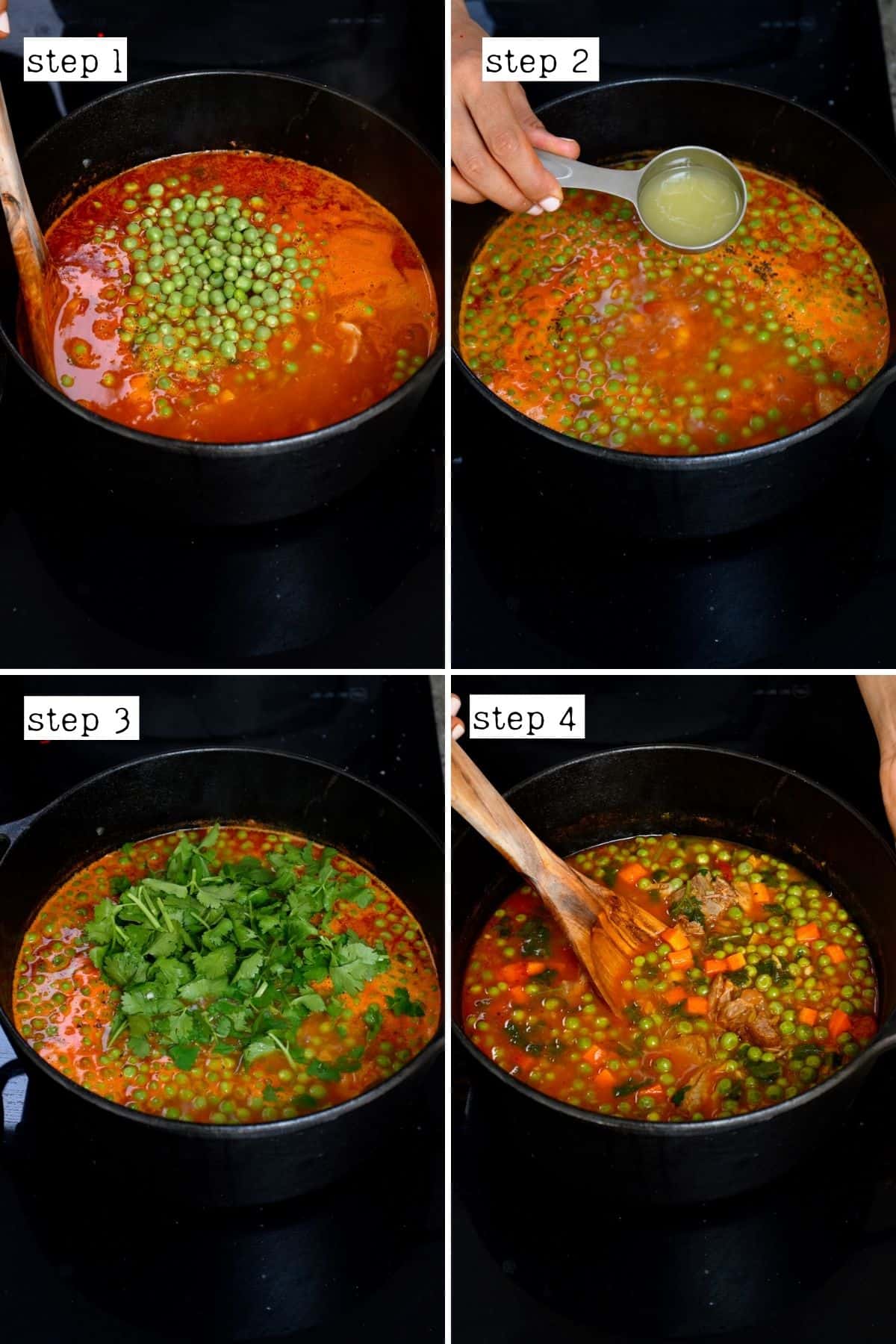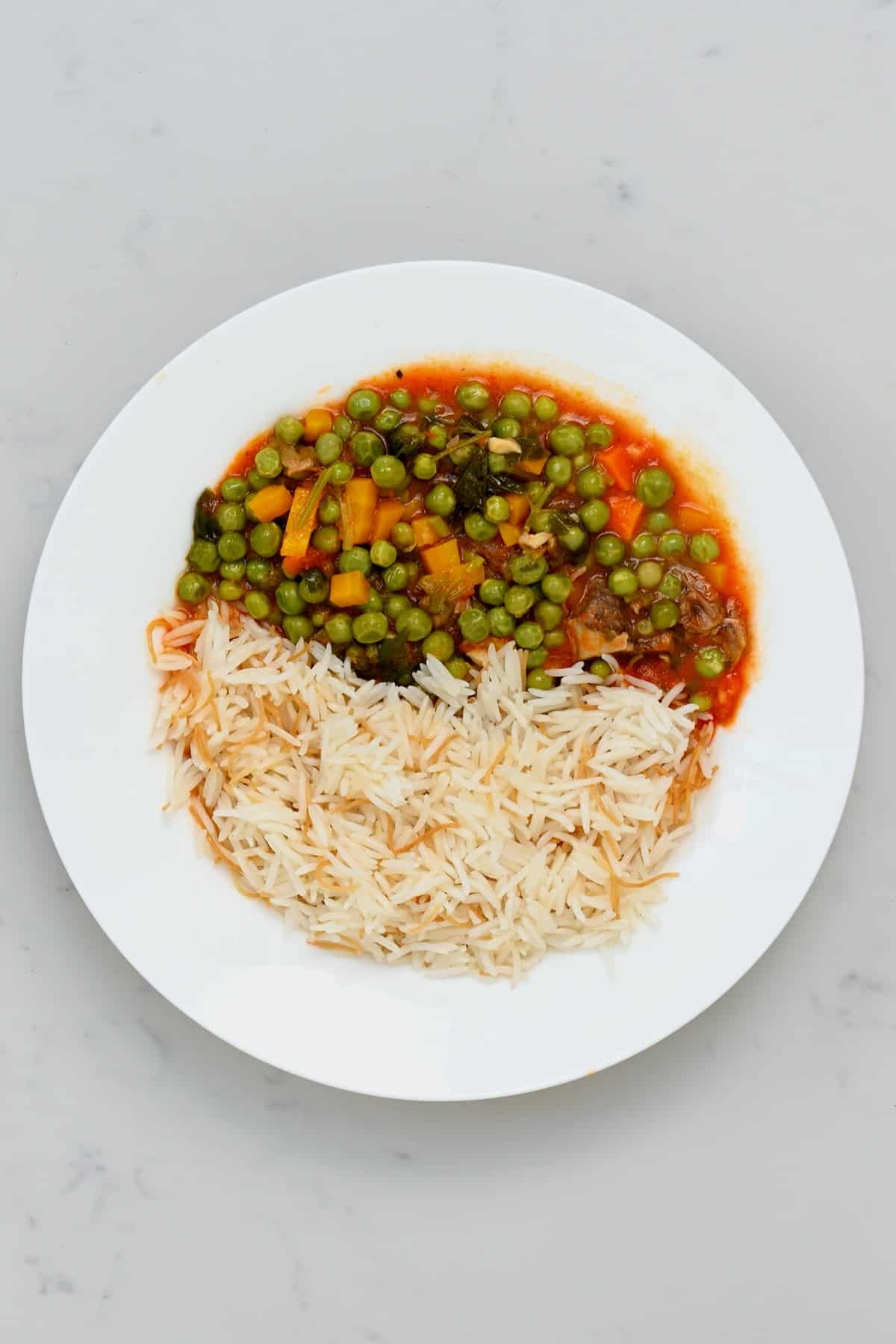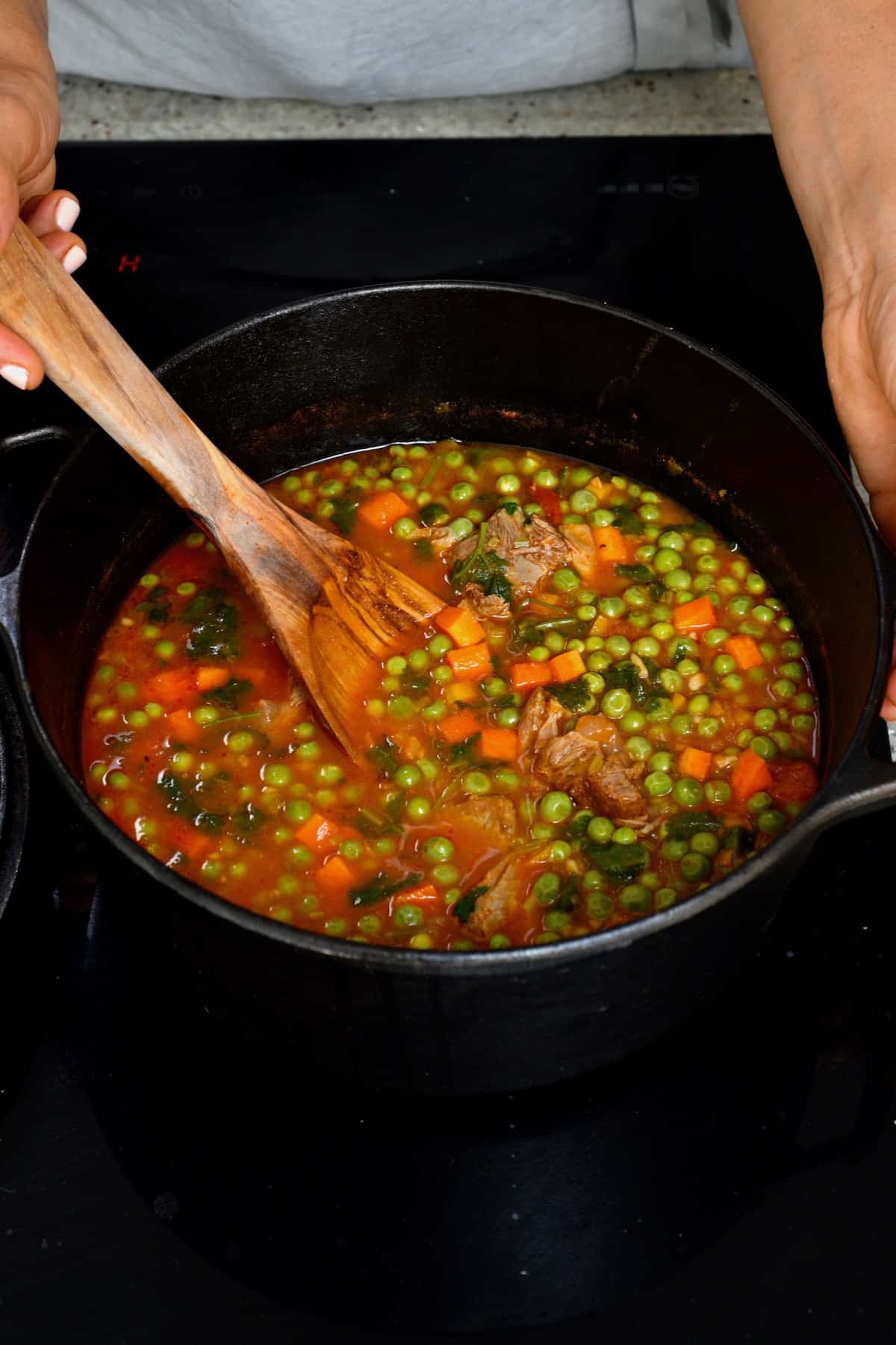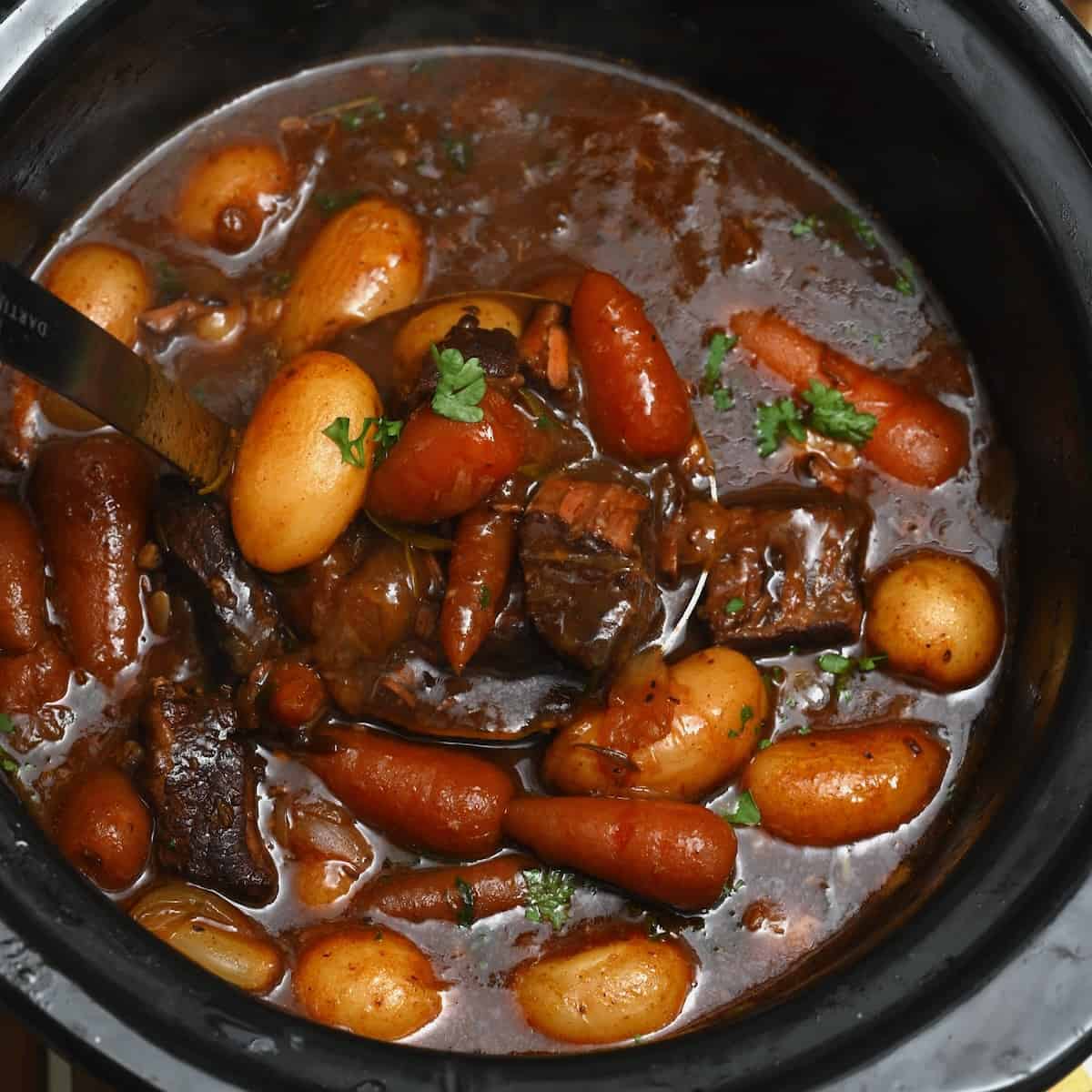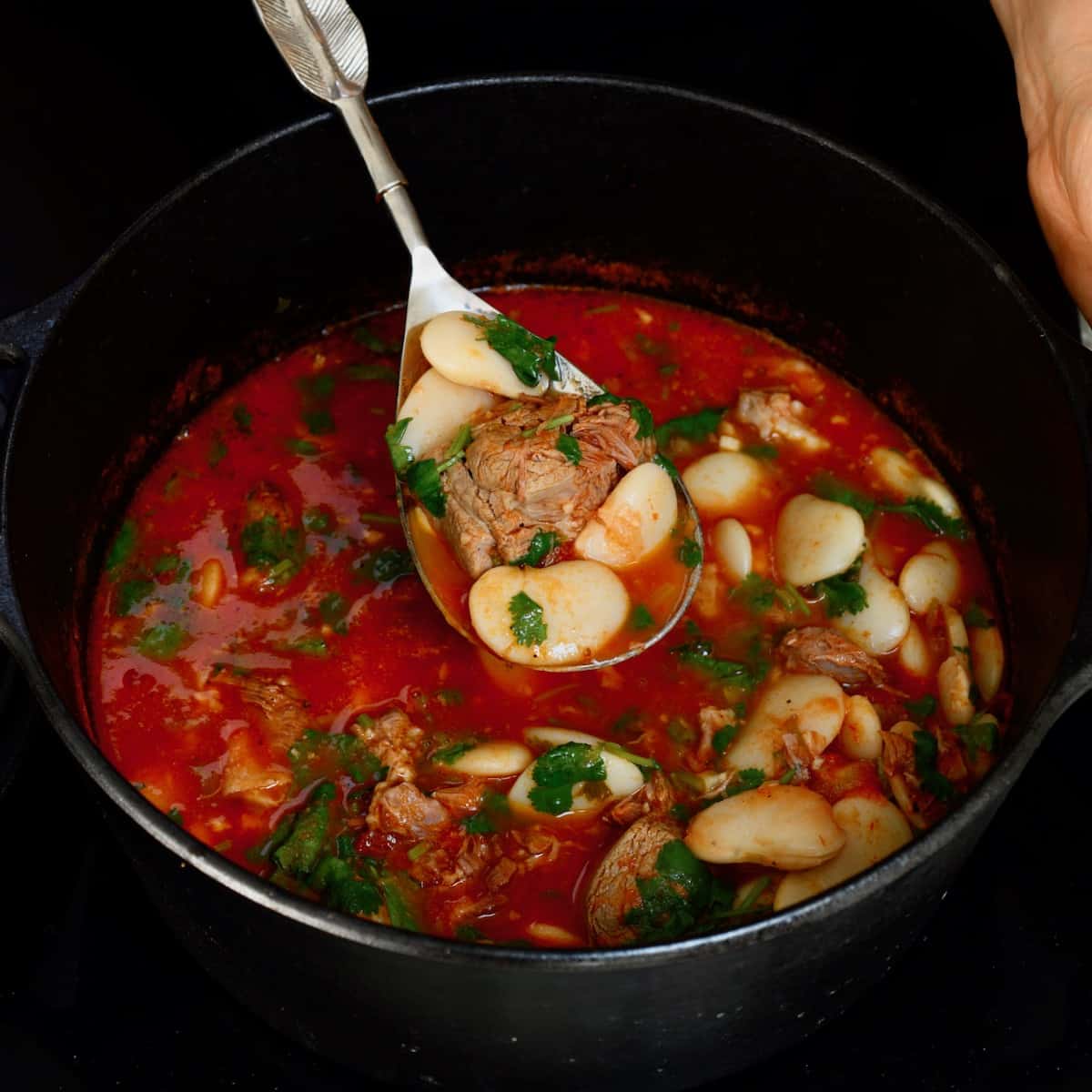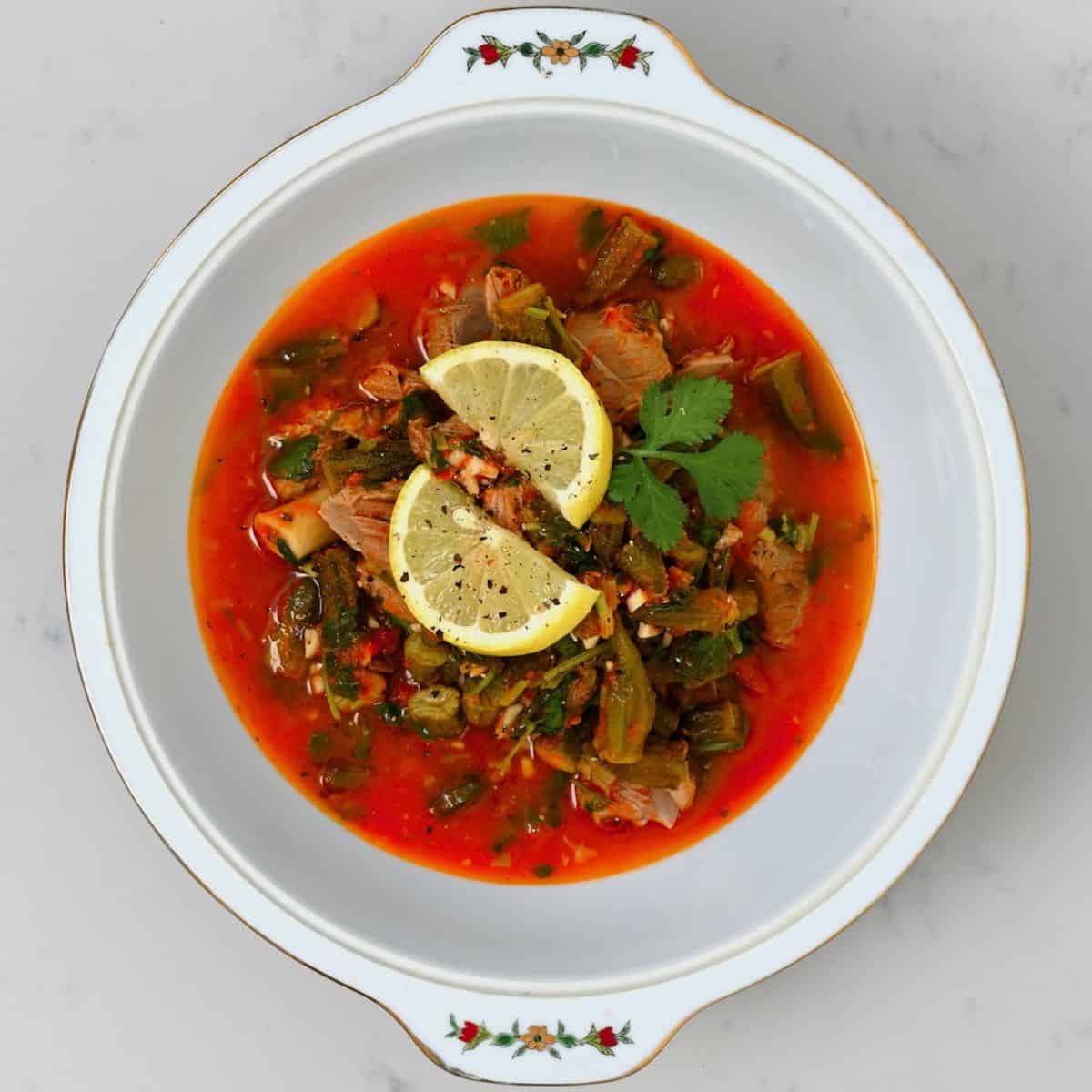What is Bazella?
This is my third Lebanese stew recipe this month, as part of an exciting project I’m working on. All three have been an Arabic-style stew called yakhneh/yakhni/yekhne – usually, a stew with a tomato and garlic base, a protein, main vegetable, and then served over a bed of rice. Just like bamia (okra stew) and the fasolia (bean stew) before it, this stew is named after its main ingredient: bazella, aka peas. This simple green pea stew combines the humble pea with carrots and meat (optionally) in a tomato-based sauce. The ingredients are gently simmered until tender and flavorful. Serve alone or with a side of buttery vermicelli rice (aka bazella w riz) for a delicious and nutritious mid-week meal! With carrots and peas as its main ingredients, this bazella is not only cost-efficient, but you can enjoy it year-round. In fact, you can even enjoy it with frozen peas and carrots (making it great as a last-minute dinner when you can’t think of what to eat)! Plus, the meat is 100% optional. For this stew, I’ve included the option of using lamb or beef shank or beef pieces. However, if you’ve spent much time on my blog, you’ll know I eat plant-based 90% of the time, so I have, of course, included meat-free options for all my recently posted “meaty” stews! Either way, this bazella w riz is comforting, cozy, and packed with flavor and nutrients. More so, it’s easy to make, can be ready in under an hour, and is meal-prep friendly (both for the fridge and freezer!). If anything, it continues to taste better and better as the days go by. Best of all, it’s a great way to get veggie-wary kids to eat more of the rainbow! For now, though, let’s jump into the bazella recipe. However, if you want more Lebanese recipe inspiration, you may also like batata harra (spicy potatoes), za’atar manakish (flatbread), falafel wrap, and/or stuffed makdous (cured eggplant)!
The Ingredients
Tomatoes: you can use fresh tomatoes, tomato juice/passata, or even tinned crushed tomatoes. You’ll also need tomato paste (I use homemade). Peas and Carrots: you can use fresh or frozen peas and carrots. I usually use fresh. However, you could even use a bag of pre-chopped/prepared peas and carrots (saving prep time!). Meat: you’ll need cooked lamb or beef shank (or beef cubes from shoulder) with beef stock for the meaty version (traditional). Keep reading in the next section for the vegetarian/vegan option. Garlic: adjust the amount to personal taste. Olive oil: I recommend using a light extra virgin olive oil, though another neutral cooking oil will work like avocado oil. Spices: you’ll need ground coriander seeds and salt and pepper. Lemon juice: use fresh lemon juice for the best and freshest results. Lime juice would also work. Cilantro: you can use fresh or frozen cilantro (no need to “thaw”).
Optional Add-ins and Variations
Vegan/Vegetarian bazella w riz: simply omit the beef, use vegetable stock, and add an onion for the simplest adaption to a vegan rice with peas and carrots stew recipe. However, for additional protein, you could make up for the meat with a meat alternative. I recommend using tofu puffs (which soak up all the stew juice for tons of flavor), tofu crumble, or a vegan beef/chicken “chunks” alternative. Adjust the cooking method accordingly. Onion: even if you aren’t adapting this to a vegan yakhnet bazella, onion is a popular inclusion to this peas and carrots stew. Potato: for an even heartier stew, you can add cubed potatoes. Add them at the same time as the carrots. Cumin: I recommend adding around 1 tsp to this Lebanese beef stew. Cinnamon: cinnamon pairs particularly well with lamb but generally works for the pea stew when it’s made meaty. Bay leaf: you can add a bay leaf to the pan when simmering the tomato sauce or when cooking the meat for extra flavor dimension. Lebanese 7 spice/allspice: I recommend around 1 tsp to the carrot pea stew. Spice: feel free to add a finely chopped chili or some chili/cayenne powder for a little heat. Adjust the amount to personal taste.
How to Make Lebanese Carrot Pea Stew (Bazella)?
Step 1: The Pre-prep
You’ll first need to prepare the beef/lamb (if using). You could also cook the vermicelli rice or rice of your choice in advance (or cook it while preparing the bazella stew).
Step 2: Prepare the Ingredients
If you’re using fresh peas, start by washing and drying them well. Then, finely dice the carrots, chop the garlic, and juice the lemon. At the same time, separate the cilantro into stalks and leaves, then finely chop the stalks. The leaves can go back into the fridge for now (to keep them fresh) until we need them later. Try to cut the carrots as evenly as possible, so they cook evenly too.
Step 3: Sauté the Ingredients
Add the olive oil to a large, heavy-bottomed pan (or Dutch oven) and heat over medium heat. Once hot, add the garlic. Sauté for 30-40 seconds. Then add the ground coriander seeds and tomato paste and stir. Sauté for two minutes. Then, add the tomato “juice” (or passata/crushed tomatoes) and cilantro stems and allow the mixture to simmer for 10-15 minutes to thicken and reduce.
Step 4: Add the Meat
Add the cooked meat and stock (if using – otherwise add vegetable stock for a vegan bazella). Mix well, then simmer over low heat for 20-25 minutes to slowly thicken and reduce. Stir occasionally. If you prefer a thicker/thinner stew, you can use a little less/more stock or simmer it slightly longer.
Step 5: Add the Remaining Ingredients
Add the peas to the pan and stir, cooking for 2-3 minutes. Then add the salt and pepper (to personal taste), stir, and cook for a further minute. Finally, add the cilantro leaves and lemon juice, mixing and then removing the bazella from the heat. Serve the bazella with vermicelli rice and lemon wedges or the sides of your choice.
How to Serve?
Traditionally, you can enjoy this Lebanese bazella w riz (carrot and pea stew) alongside rice; vermicelli rice, brown rice, basmati, or white rice will all work. Quinoa or cauliflower rice (low carb) would also pair well. Optionally, top with a dollop of plain natural/Greek yogurt. You could additionally serve it alongside a simple leafy green salad, a carrot salad, and/or pita bread or a similar flatbread (like Ramadan pide) for mopping up the stew sauce. Carrots and peas also pair well with potatoes – like mashed potatoes or to top baked potatoes. Interestingly, you could even use this Lebanese pea stew as a pasta sauce with homemade pasta, vegan pasta, or GF chickpea or red lentil pasta.
How to Store?
Store: Allow the bazella to cool, then store in an airtight container in the fridge for up to 5 days. Freeze: This bazella (carrot and peas stew) freezes very well. Store the cooled Lebanese carrot and pea stew in an airtight container/s for up to 3 months. Allow it to thaw overnight in the fridge before reheating. Reheat: You can reheat the pea and carrot stew gently on the stovetop or in the microwave until heated through. Add an extra splash of water (or stock) to bring it back to its’ saucy stew-like consistency, if needed.
For a one-pot dish: It’s possible to cook the meat (beef chunks) with the stew to make this a one-pot dish. Start by browning the meat for several minutes (until a slight crust appears and slight caramelization) before adding the onion and sauteing for a further minute. Then remove the meat and continue with the recipe – adding it back in at step 4, as written. The time it takes to simmer the bazella until the meat is tender will vary on the meat used, size, and quality of the meat. Between 30-50 minutes is a rough estimate. For this method, I recommend using tough, lean cuts of feet (like beef chuck) as they can handle the long cooking time without falling apart OR becoming too chewy. Adjust the flavor: This homemade Lebanese stew is very simple to adjust. Add more tomato puree for extra richness, adjust any of the spices, add some chili/chili powder for heat, adjust the amount of salt and pepper, etc. Use my recipe as a rough guideline to tweak to your version of perfection. For an oil–free version: You can use a little vegetable stock (or beef stock) to sauté/sweat the garlic initially. For a thicker stew: If you want a thicker stew without overcooking the meat/veggies, you can use cornstarch to thicken the mixture. I recommend creating a slurry (combine ½ tbsp of cornstarch with 1 tbsp warm water and mix to combine until no lumps). Then add the slurry to the stew and cook for several minutes until it thickens/ Do this right at the end of the cooking process.
More Hearty Recipes
Easy Slow Cooker Beef Stew Recipe Butter Bean Stew (Fasolia Recipe) Okra Stew (Bamya/Bamia Recipe) Green Bean Stew (Braised Green Beans) Perfectly Braised Lamb Shanks
If you try this Lebanese bazella recipe, I’d love to hear your thoughts and questions below. Also, I’d appreciate a recipe card rating below, and feel free to tag me in your recipe recreations on Instagram @Alphafoodie!

